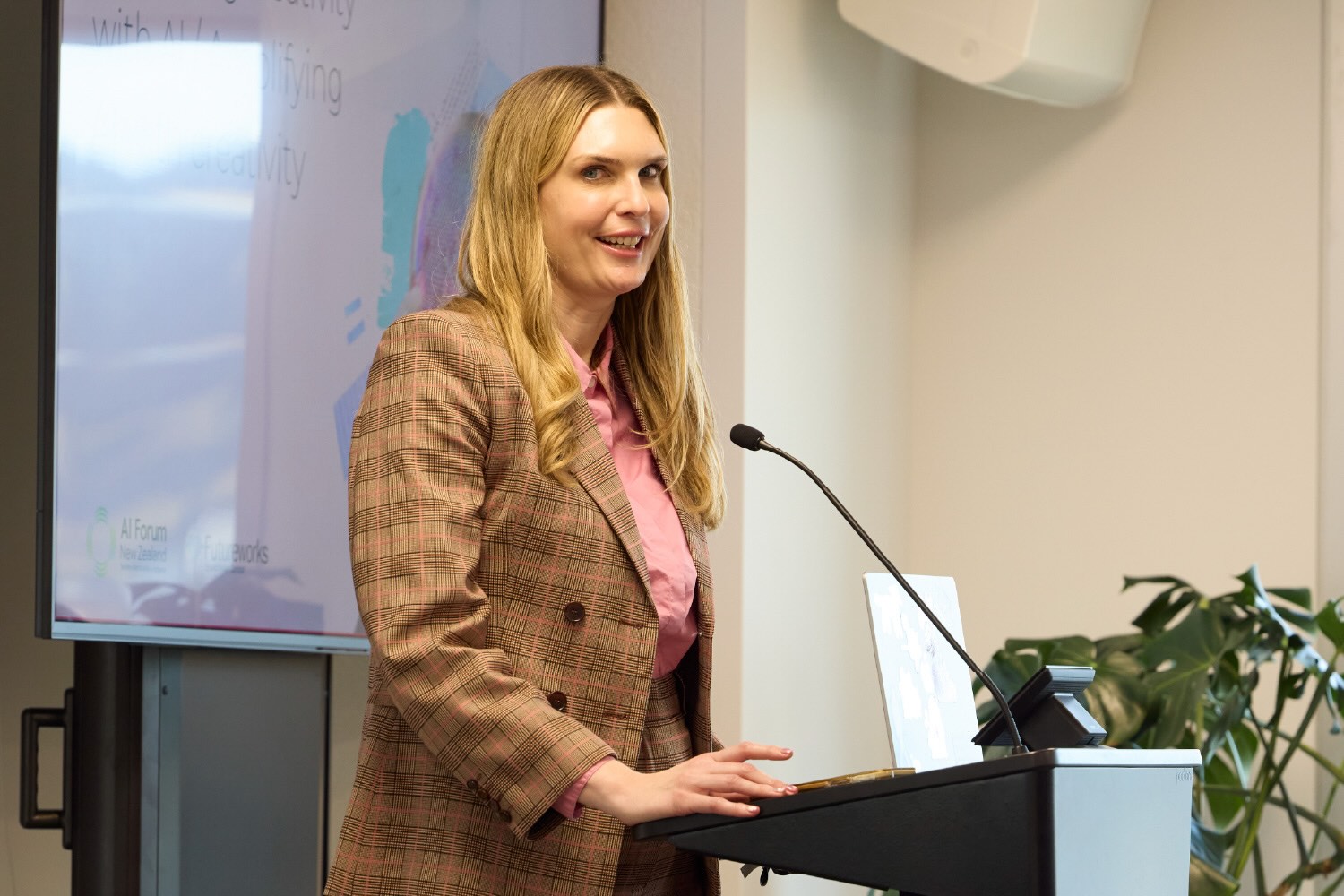Do you have a question? Want to learn more about our products and solutions, the latest career opportunities, or our events? We're here to help. Get in touch with us.

From novel-writing AI bots to software that creates cinematic video clips in response to a handful of text prompts, the creative industries are on the front line of the generative AI revolution.
But that doesn’t mean our filmmakers, artists, photographers, and musicians are pulling up the drawbridge on AI. Last week’s AI in Creative Industries Summit, hosted by the AI Forum and held at Datacom’s Wellington HQ, was marked by a sense of optimism and possibility about the power of AI, even if the rapidly evolving technology poses challenging and complex legal, ethical and economic questions.
Leading voices from New Zealand’s creative, public, and technology sectors shared how AI is already reshaping creative workflows, democratising access to tools, and prompting new questions about human uniqueness, trust, and the future of work.
While challenges and anxieties were acknowledged, the prevailing mood was one of excitement about the opportunities ahead, says Lou Compagnone, Datacom’s Director of AI and an author and musician herself.
“The sense I got, what all these great panellists were saying, was they see AI as a tool to amplify human creativity and not replace it,” she said.
Across the Summit’s panels, participants described their use of a wide range of AI applications:
Rapid prototyping and ideation: AI tools are enabling creators to explore ideas, generate concepts, and iterate at unprecedented speeds. In game development and visual effects, for example, AI helps artists “take ideas and turn them into execution”, making it possible to “do things that we’re already doing, cheaper, better, faster or safer”, said Tyrone McAuley, the Chief Operations Officer of Wellington game developer PikPok.
Productivity and efficiency: In both public and private sectors, AI is being used for tasks like transcription, translation, content summarisation, and workflow automation. These applications free up time for more creative or human-centred work.
Personalisation and accessibility: Broadcasters and cultural organisations are experimenting with AI to personalise content delivery and make media more accessible. Te Papa is using generative AI to create summaries for some of its collection items, so more can be shown to the public online.
Creative experimentation: Artists are using AI as a collaborator, feeding in their own data and experience to generate new works. One artist described compressing “three months of production into two weeks” by leveraging AI trained on their unique archive.
With New Zealand’s film and video games industries generating billions of dollars in export revenue each year, several speakers argued that AI could help New Zealand address chronic productivity challenges and open up new economic frontiers.
New Zealand has a well-documented productivity problem. “We suck at it to be blunt,” said Holly Knill, a former broadcasting executive who is currently completing a university thesis examining how New Zealand's businesses can use AI to improve productivity.
“I think [management consultant] Peter Drucker probably nailed it when he said that the best way to predict the future is to create it. What I'm looking at here today are some of the people who are more than capable of creating it,” Knill told the Summit.
“That will mean more people can create more futures, faster, better, smarter than they ever have before. Our next opportunity is to make a lot of money out of that. I'm pretty sure all governments will thank us for it.”
Several panellists noted that AI is fostering new forms of collaboration across disciplines, as teams work together to understand and harness its capabilities. AI is also unleashing creativity in people who may not have thought they were creative by making previously impossible creative endeavours more accessible. But the potential downsides loom large too.

Despite the optimism, participants were clear-eyed about the risks and challenges.
In journalism and public service, there are serious concerns about AI-generated “hallucinations” and misinformation. A public broadcasting executive said his organisation didn’t allow the use of generative AI to produce news articles because of concerns over hallucinations and misinformation.
There is anxiety that over-reliance on AI tools could erode foundational skills. Fears about job losses and changing roles were acknowledged, with many attendees employed in highly specialised technical roles in film and music production that are rapidly being automated.
The Summit’s speakers called for strong guardrails, especially around data privacy, copyright, and the use of indigenous and cultural content. An overriding theme from Lou Compagnone and several of the other speakers was that, even as AI advances, creativity remains uniquely human.
“AI can write poetry on patterns and conventions it’s learned from other poems, but it can’t feel inspired by something, or it can’t experience the spontaneous, unstoppable need to create, that we understand as inspiration.”
The challenge is to “harness the complementary strengths of human and artificial intelligence to create something greater than either could achieve alone”.
Compagnone adds that part of managing the inherent risks of AI is that we view it as a tool that we can and should remain in control of, an idea that has also been discussed by researchers at Columbia University’s Knight First Amendment Institute. Organisations need to take an active approach to determining the role AI will play for their teams and in their operations and focusing on “putting AI to work”.
The consensus was that New Zealand’s creative industries are well-positioned to lead in this new era — if they remain curious, values-driven, and focused on amplifying what makes us human.
Compagnone had some advice for attendees bewildered by the rapid advance of AI into their industries: start experimenting with AI now.
“Rather than waiting for the perfect AI tool to help do this, actually just to dive into the current tools that are available and just start playing around with what they can do,” she advised.
“But I also think it's important to look at the future horizon as well, and stay across what is actually changing with AI.”